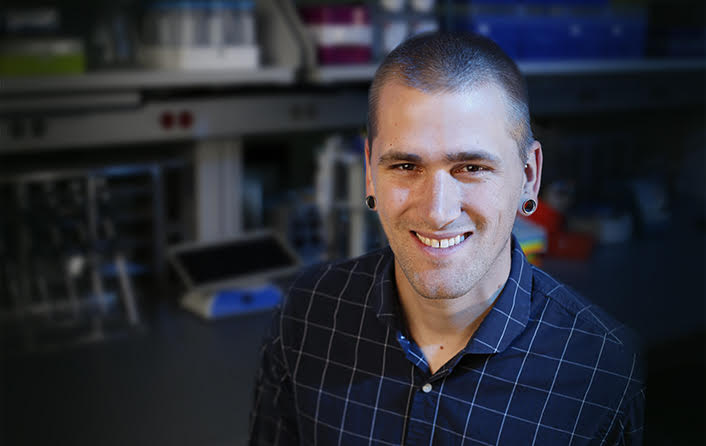
-
- Posted Thursday April 23, 2020
TGen contributes to international studies identifying cell-types susceptible to SARS-CoV-2 infection
Shaped like champagne glasses, goblet cells express an enzyme that allows the COVID-19 coronavirus’ spikes to bind with and enter airway cells
PHOENIX, Ariz. — April 23, 2020 — Two significant international studies involving hundreds of scientists, including a human geneticist at the Translational Genomics Research Institute (TGen), an affiliate of City of Hope, suggest that specific cells in the human nasal passage shaped like a champagne glass, known as goblet cells, may play a significant role in enabling COVID-19 infections.
Two studies, one published today in Nature Medicine and a similar study published April 22 in the journal Cell, indicate that goblet cells highly express a receptor enzyme called ACE2 that binds to the spikes covering the outer surface of SARS-CoV-2, the virus that causes the COVID-19 disease.
“These studies largely agree with each other and provide new insights into the specific type of cells targeted by the SARS-CoV-2 infection,” said Dr. Nicholas Banovich, a TGen Assistant Professor and member of the Lung Biological Network of the Human Cell Atlas, an international effort to create comprehensive reference maps of all human cells as a basis for diagnosing, monitoring and treating disease.
“When the COVID-19 crisis began, it became clear that these large datasets generated by members of the Human Cell Atlas community were a valuable resource to study which cell types were expressing key genes related to the SARS-CoV-2 infection,” Dr. Banovich said.
In both studies, goblet cells — which produce mucus in the nasal passages — were found to overly express angiotensin-converting enzyme 2 (ACE2), which serves as the entry point into cells for some coronaviruses.
“A lot of information was known about the path of infection from previous studies of SARS-CoV, including the fact that the first step in viral entry into the human body is the binding of the coronavirus spike protein to the ACE2 human receptor and an associated gene called TMPRSS2, which helps activate the coronavirus spike protein, enabling it to enter the cell,” Dr. Banovich said.
Using data sets from the Human Cell Atlas, the Nature Medicine study used single-cell profiling of healthy samples to examine cells exclusively in the human airways, including nasal passages, lower airways and the lungs. The study revealed that two types of cells in the nasal passage — goblet and ciliated cells — most highly expressed ACE2 and TMPRSS2. In addition, it found that ACE2 also is expressed in AT2 cells in the lungs.
“The results of these studies suggest that these cells in the nasal passage may serve as a viral reservoir, helping to disseminate the virus within an individual and spread the disease between individuals,” Dr. Banovich said.
Using existing and new data, the Cell study looked at multiple human, primate and mouse tissues. This study also found that nasal goblet cells highly express ACE2. In addition, researchers found expression of ACE2 in absorptive enterocytes within the gut, which could help explain why many COVID-19 patients have GI symptoms.
The most significant finding in this study, however, is that ACE2 is stimulated by interferon, which is released by the body’s immune system in response to viral infections.
“The body’s own immune system may be causing neighboring cells to become targets of the virus,” Dr. Banovich explained. “A patient’s own immune response may be creating new shots on goal for the virus’ target.”
Both studies represent the first major collaborative effort by the Human Cell Atlas’ Lung Biological Network.
“These two studies really demonstrate the power of the Human Cell Atlas community and of single cell RNA sequencing. Pulling together this large group of researchers and data sets allowed the science to move at incredible speed,” Dr. Banovich said.
Both studies rely on a relatively new technology called single cell RNA sequencing (scRNA-seq), which allows researchers to delve into the specific molecular characteristics of individual cells, the fundamental units of all life. Dr. Banovich and Assistant Professor Dr. Johathan Keats, TGen Director of Bioinformatics, were selected in 2017 by the Chan Zuckerberg Initiative to optimize the processing of samples for scRNA-seq analysis as part of the Human Cell Atlas project.
The study published today in Nature Medicine, titled SARS-CoV-2 entry factors are highly expressed in nasal epithelial cells together with innate immune genes, can be found at https://www.nature.com/articles/s41591-020-0868-6.
The study published Wednesday in Cell, titled SARS-CoV-2 receptor ACE2 is an interferon-stimulated gene in human airway epithelial cells and is detected in specific cell subsets across tissues, can be found at https://www.cell.com/pb-assets/products/coronavirus/CELL_CELL-D-20-00767.pdf.
# # #
About TGen, an affiliate of City of Hope
Translational Genomics Research Institute (TGen) is a Phoenix, Arizona-based non-profit organization dedicated to conducting groundbreaking research with life-changing results. TGen is affiliated with City of Hope, a world-renowned independent research and treatment center for cancer, diabetes and other life-threatening diseases: www.cityofhope.org. This precision medicine affiliation enables both institutes to complement each other in research and patient care, with City of Hope providing a significant clinical setting to advance scientific discoveries made by TGen. TGen is focused on helping patients with neurological disorders, cancer, diabetes and infectious diseases through cutting-edge translational research (the process of rapidly moving research toward patient benefit). TGen physicians and scientists work to unravel the genetic components of both common and complex rare diseases in adults and children. Working with collaborators in the scientific and medical communities worldwide, TGen makes a substantial contribution to help our patients through efficiency and effectiveness of the translational process. For more information, visit: www.tgen.org. Follow TGen on Facebook, LinkedIn and Twitter @TGen.
Media Contact:
Steve Yozwiak
TGen Senior Science Writer
o. 602-343-8704
c. 602-620-4749
[email protected]


